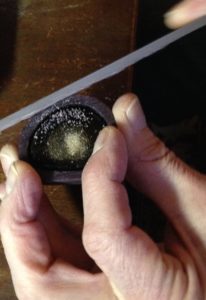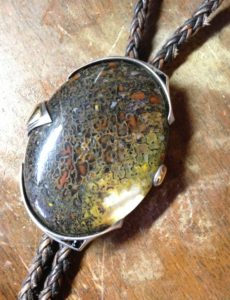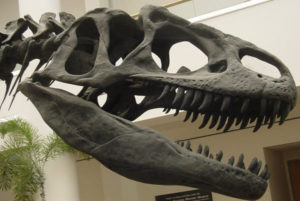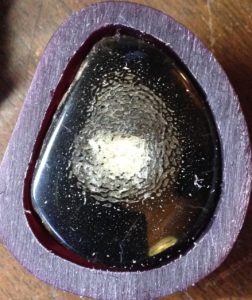A long time ago (about 150 million years), dinosaurs ruled southern Utah. When they died, if the conditions were right, their bones turned to fossils. Most fossils here are from the Morrison Formation, a huge swath of sedimentary rock from the Late Jurassic period, extending from southern Canada to Arizona and New Mexico.
A short time ago (in the 1970s), Charley Hafen stumbled across agatized dinosaur bone and had friends who collected pieces, too. (The Antiquities Act of 1906 requires a permit for excavating any cultural or natural resource on public lands, but only a nod from the landowner stands in the way of hunting and collecting on private lands.)
The Salt Lake City jeweler now has an excellent inventory of stunning rocks with which he makes equally stunning pieces of one-of-a-kind jewelry. Read more about Hafen here.
I stopped by to check on the process of a custom belt buckle made from some black and quartz dinosaur bone. I’m guessing it was an Allosaurus, one of the most common dinosaurs around here back then. In 1988, it was declared the state’s official fossil.
For starters, Hafen carefully sliced a section of the bone-turned-stone and reinforced it with PaleoBond, a structural adhesive made especially for this purpose. He then shaped it best for the centerpiece of the buckle, in which the sparkling quartz of the piece would favorably highlight its black body.
Hafen then fashioned a wax mold around the stone. Using the Lost Wax Casting technique, he carved and filed the wax to a precise design that would, in time, be silver.
Hafen worked the wax with skill, using three different files and a tiny Al Mar knife, blowing away wax dust while fluidly turning the mold in his hands.
“I like the idea of going as far as I can with wax,” said Hafen. “More detail will be done when it’s metal, but I can get it to nearly a jewelry finish in wax.”
 Once he achieved the desired look, he placed the mold in a ceramic cylinder and in a kiln. Using centrifugal force, the wax melted and spun away. Silver took its place.
Once he achieved the desired look, he placed the mold in a ceramic cylinder and in a kiln. Using centrifugal force, the wax melted and spun away. Silver took its place.
The process is an expedited variation of what happened to the dinosaur bone way back when. A sort of swapping of substances. Gradually, minerals from the surrounding ground water were deposited in the big and small microscopic holes of the bone and blood vessels. The color and composition of the resulting fossil varied according to the chemistry of the water and the density of the bones, said to Dr. Randall Irmis, assistant professor of geology at the University of Utah and paleontology curator at the Natural History Museum of Utah.
Art, history, and science all in a belt buckle.



